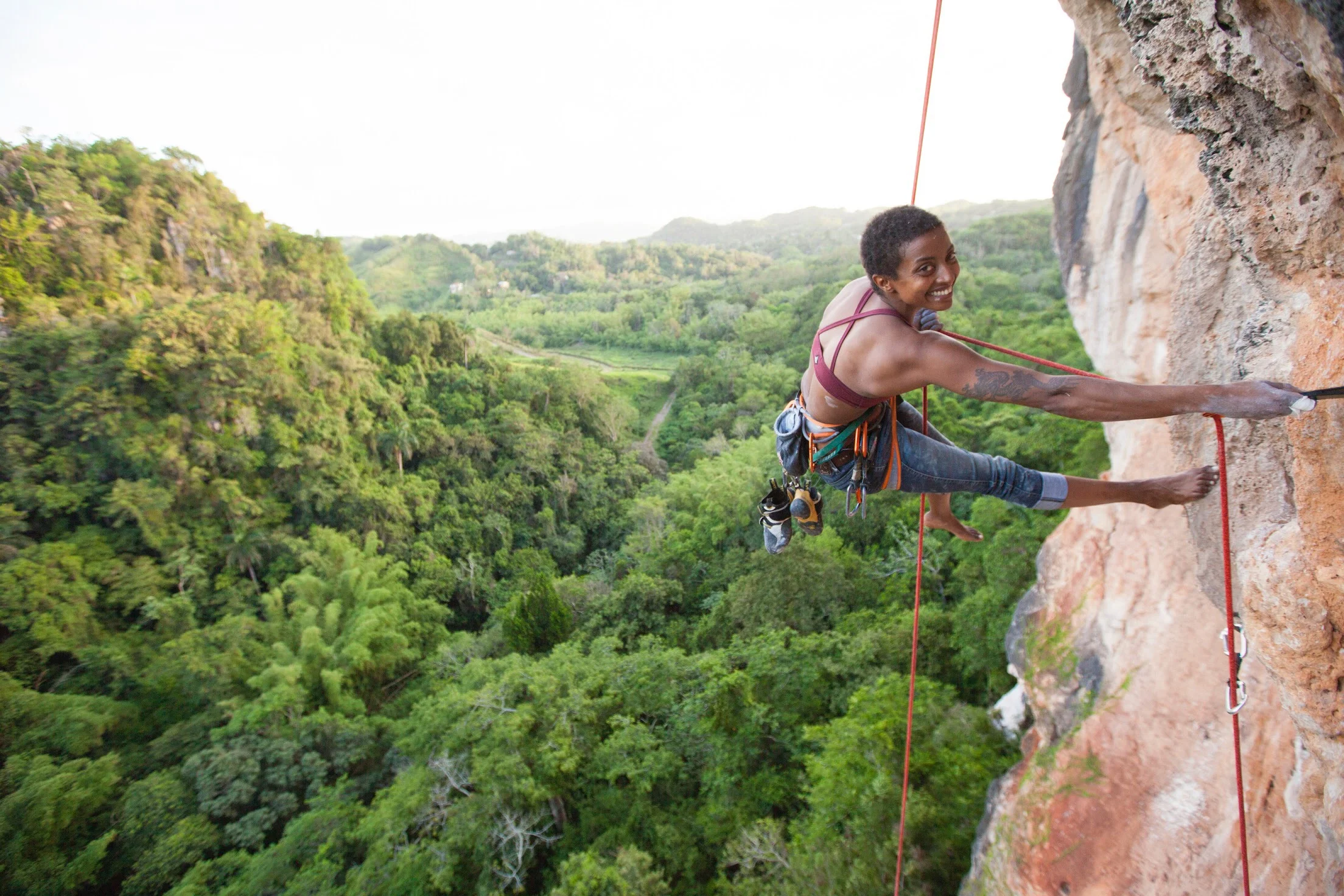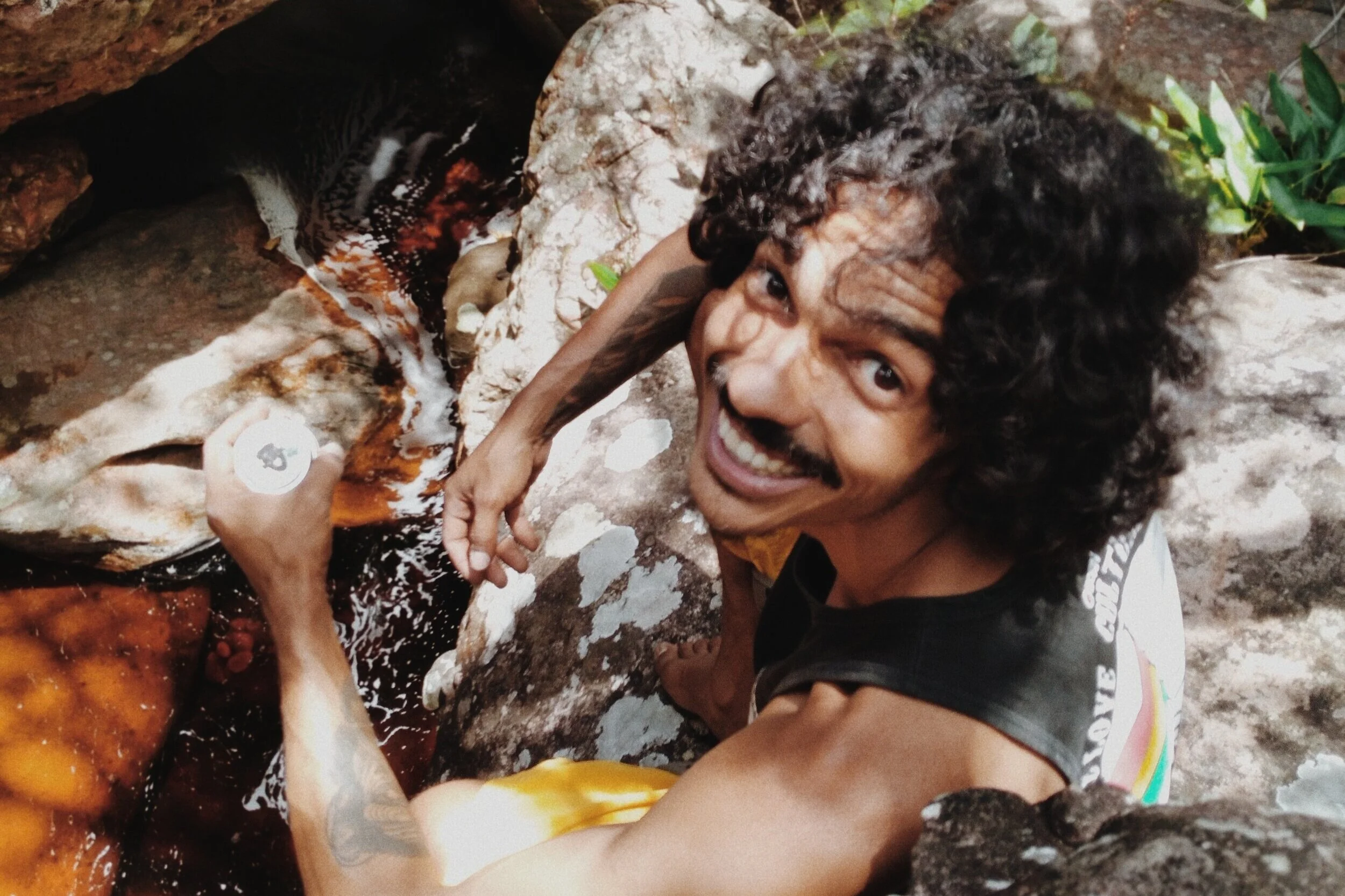Meet the First Black Woman to Be Featured on the Cover of a Climbing Guide
Sabrina climbs her 5.14a project, Titan, in Bruce Peninsula National Park, Ontario, Canada. Photo courtesy of Shawn Robertson
Sabrina Chapman is a climbing phenomenon from Toronto, Ontario, Canada. She didn’t start rock climbing until she was 26-years-old. Now she’s on a mission to complete her first 5.14a, the threshold for elite climbing.
In 2016, she became the first woman to be featured on the cover of a Canadian climbing guide, the first woman to complete a 5.13d grade ascent in Ontario, and possibly the first black woman ever to land the cover of a climbing guidebook according to Ontario Rock Climbing.
We interviewed Sabrina to find out how she got started and how you can too!
What made you decide to start climbing?
Ryan [her partner] had tried climbing a bit while a teenager and then picked it up again after we got married. I went to the climbing gym with him to try it out and loved it right away.
How did you end up sport or route climbing? And what was your progression? Did you initially start out top-roping at a climbing gym?
I had a membership to a gym that was 95% route climbing, so it was really all I was exposed to. I top-roped for a year before I decided to do a lead climbing course […] But really, I just wanted to keep challenging myself so lead climbing seemed like the next logical step.
How long was it before you started lead climbing? What was that experience like?
It was one year before I started lead climbing. At first I was terrified. The final test was to climb past your last protection and then let go of the holds and fall. This would happen in the late afternoon/early evening, when the gym was pretty full. Everyone would stand around and watch. If you seemed hesitant, people would yell out encouragement, but I didn’t really hear any of that. I remember closing my eyes and saying to myself “You’re good Sabrina, just let go” and I did! I felt a huge sense of relief although I tried to act like it wasn’t a big deal.
What would your advice be to a woman of colour who wants to start climbing?
If you feel hesitant or unsure because no one looks like you, or it’s something only white people do, try to flip the script. Do it because of that. Do it because you’ve tried new things before, and sure—it was hard at first, but you stuck with it and you did it! I really believe climbing allows us to use our bodies and mind cohesively in a way that’s so unique and empowering.
Is it difficult to find climbing partners as a new climber?
It can be difficult to find a partner to do routes in a gym if you just show up; the good thing is gyms now often have sign up boards where people can post that they’re looking for a partner and the times they’re available. With bouldering it’s much easier to find people to climb with, as you often end up working problems with strangers and connect through problem solving the boulder together.
Are new climbers required to purchase a harness or climbing shoes right away?
You don’t have to buy a climbing harness, shoes or chalk bag right away. Gyms rent equipment or often have deals where they’ll offer the price of admission and equipment at a discounted price.
Climbing trivia: Did you know that Dr. Favia Dubyk is the second black woman to be featured on the cover of a climbing guide? She was photographed by Irene Yee for the 2019 version of the Texas Canyon Guidebook.
How did you deal with the challenge of learning something new (and technical) as the only person who looked like you? Was it intimidating?.
I think I was so engrossed in trying to become a good climber that I was able to put being outside the status quo aside, for the most part. I wasn’t intimidated because I wanted to show myself I was strong and capable.
You didn’t start climbing until you were 26 years old; what advice would you give to other climbers who are starting “late”?
Although it can feel difficult to do, do not let yourself be distracted by how good everyone else around you seems to be. Stay focused on your own goals, your own mini accomplishments and surround yourself with genuinely encouraging people who are not interested in one upmanship.
Do you have to work overtime to prove that you are qualified or do strangers assume that you are competent?
I think in the past, I made a point of people knowing how competent I am in my own right, but now I’m confident enough to let my climbing speak for itself. I’m still met with surprise by strangers or people who don’t know me when I show up to a crag and put up my own quickdraws or send things quickly.
Melanin Base Camp is raising $24,051 in 30 days in order to produce a short film about Sabrina and we need your help! To learn more, check out our Kickstarter.
How did you end up on the cover of the Ontario Rock Climbing Guide?
The photo was taken by Kyle Thomas (Leslie Timm’s husband), when Leslie and I were working the same route, a 13d. While Leslie rested, Kyle went up and grabbed this shot.
At that time, Jesse Wong was working on Ontario’s second guidebook. The first one was printed in the ‘90s, so the community was really in need of an updated book.
The following week, I sent that route. It was my first of the grade [5.13d], and the first female ascent of that grade in Ontario.
Jesse texted me that photo saying he was excited to have it for the new guidebook. I thought he meant just including it in the book, but he explained he wanted to put it on the cover.
My initial reaction was to tell him I was uncomfortable with that; I didn’t want the attention. He replied by saying representation is important. And I had no argument to that, so I agreed.
Why is it important for girls and young womxn of colour to see womxn of colour, like yourself, climbing at elite levels?
I think for a long time, the climbing story we’ve been told has not reflected our lived experience, and the assumption has always been that that mainstream story is the default of what a climber is. When a girl or young womxn of colour sees me climbing, they’ll inherently know that I’ve experienced racism, discrimination, and sexism because to some degree, they’ve experienced it as well. When that same group also sees me climbing hard, pushing my limits and taking up space outside, a new story emerges that can also be theirs. It’s important for those girls and womxn to see their own story and potential reflected in the mainstream.
Melanin Base Camp is partnering with Beast Fingers Climbing to produce a short film about Sabrina and we need your help. To learn more, check out our Kickstarter.
Update: The article was revised to show that Sabrina became the first known black woman to land the cover of a climbing guide book in 2016.
It was also revised to include the second black woman to be featured on the cover of a climbing guide book, Dr. Favia Dubyk, who was photographed for the cover of the 2019 version of the Texas Canyon Guide.
















I was recently lucky enough to make my first voyage to one of the top climbing destinations in the world: Fontainebleau—or Font. For most of my climbing career, I’d heard stories about the beautiful sandstone boulders and the flat, sandy landings. I knew I had to experience it for myself one day.
But planning a climbing trip to a foreign country can feel overwhelming and even a little scary, especially if it’s your first time. To help make your experience smoother and more enjoyable, here are some tips I picked up along the way.